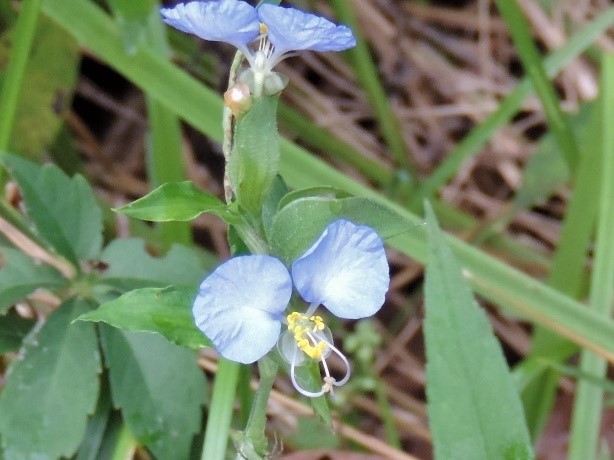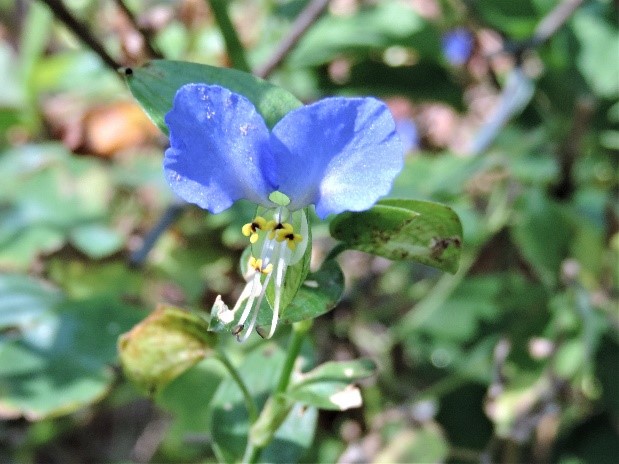by Kathy Bildner
Wild Ones St. Louis Chapter member and Chairperson, Grant Committee
If you are looking to identify a plant and all you know is the color, try the Missouriplants.com web pages.
To further narrow down your choices, it is helpful to know if the leaves are one of three arrangements: opposite from each other, alternate or whorled along the stem. (Examples below)

Leaf arrangement examples
Left –Alternate as in Cliff goldenrod, Middle – Opposite as in Royal catchfly or Right – Whorled as in Michigan lily
On the web site you will see this list of choices by color and leave arrangement.
Choose a category:

![]() White flowers, Leaves opposite or whorled
White flowers, Leaves opposite or whorled

![]() White flowers, Leaves alternate
White flowers, Leaves alternate

![]() Pink flowers, Leaves opposite or whorled
Pink flowers, Leaves opposite or whorled

![]() Pink flowers, Leaves alternate
Pink flowers, Leaves alternate

![]() Red flowers, Leaves opposite or whorled
Red flowers, Leaves opposite or whorled

![]() Blue or Purple flowers, Leaves opposite or whorled
Blue or Purple flowers, Leaves opposite or whorled

 Blue or Purple flowers, Leaves alternate
Blue or Purple flowers, Leaves alternate

![]() Yellow flowers, Leaves opposite or whorled
Yellow flowers, Leaves opposite or whorled

![]() Yellow flowers, Leaves alternate
Yellow flowers, Leaves alternate

![]() Greenish flowers, Leaves opposite or whorled
Greenish flowers, Leaves opposite or whorled

![]() Greenish flowers, Leaves alternate
Greenish flowers, Leaves alternate
Using this guide, you should be able to find the plant you are looking to identify.
These web pages are managed by the Missouri Botanical Garden and updated by volunteers.
Originally, these pages were started and managed by Dan Tenaglia. Dan had put a lot of work into this site. It was very helpful to many people. After his death, in order to keep his site available and updated, his wife gave it to the Missouri Botanical Garden. (There is a description of Dan and his work on the web site.)
Current managers of the site are trying to list every native plant in the state of Missouri. They also list common introduced species. The list is up to 1282 plants.
A second way to use this site, if you already know the name of the plant’s genus, such as Asclepias (milkweeds), but do not know which one of the 18 Missouri milkweed species it is, click on “all the plants on this site” (see bold text below as written on the web site).
If you wish to skip the thumbnails and jump directly to
a certain plant, go to the list of all the plants on this site.
Look up the genus name Asclepias and you will see them all listed there.
Asclepias amplexicaulis
Asclepias exaltata
Asclepias hirtella
Asclepias incarnata
Asclepias meadii
Asclepias perennis
Asclepias purpurascens
Asclepias quadrifolia
Asclepias speciosa
Asclepias stenophylla
Asclepias subverticillata
Asclepias sullivantii
Asclepias syriaca
Asclepias tuberosa
Asclepias variegata
Asclepias verticillata
Asclepias viridiflora
Asclepias viridis
Click on each of them in turn to see photographs of the flower, stem, leaves, seed pods, habitat and other interesting facts. You will be able to pick out the one you have.
This site is also helpful to identify the things (I hesitate to say weeds) growing in your yard that were not intentionally put there. Smart weeds (Persicaria-16 species), Day flowers (Commelina-5 species), Violets (Viola-17 species), Fleabanes (Erigeron-5 species), Spurges (Euphorbeas-19 species), Ground cherries (Physalis-6 species) and Geraniums (6 species) are common plants in our yards that have native and non-native varieties. Examples below are the non-native Asiatic dayflower and the native White mouth dayflower both growing in my yard. Neither planted in the yard by me.
For years I wanted to know the name of a white aster (Symphyotrichum-24 species) and a spiderwort Tradescantia-8 species) that came with my yard. I was able to name them with this web site.
There is a glossary here, to help with descriptive words unfamiliar to those of us who are not botanist.
Also, you will find “cool botany links” at the bottom of the page. There are over a hundred links listed including “Wild Ones”.
This site is a work in progress and a large undertaking. There are plants that need to be added, descriptions that need to be filled with more detail, photos added to show other aspects of the plant’s life cycle, etc. However, the plants we are most familiar with are already here.
I find it a very helpful resource. I hope you enjoy using missouriplants.com as much as I do.


 Flowers of other colors
Flowers of other colors

